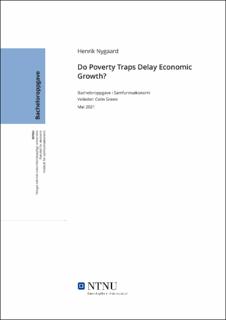Do poverty traps delay economic growth?
Bachelor thesis
Permanent lenke
https://hdl.handle.net/11250/2777093Utgivelsesdato
2021Metadata
Vis full innførselSamlinger
Sammendrag
Oppgaven ser på sammenhengene mellom fattigdomsfeller og økonomisk utvikling og om dette fungerer som en stopper på utviklingen. Fattigdomsfeller defineres som mekanismer i økonomien som forsterker fattigdom, som resulterer i en ond sirkel som er vanskelig å komme ut av uten en større grad av økonomiske midler.
Selv om det er mange faktorer som kan medføre fattigdomsfeller, fokuserer oppgaven på tre hovedvariabler: nasjonal sparing, populasjonsvekst og produktivitet. Det er tre variabler som kontinuerlig blir nevnt i tradisjonelle økonomiske vekstmodeller. Formålet med denne oppgaven er å undersøke om hvorvidt disse antagelsene til fattigdomsfeller stemmer overens med våre eksempelland. Dette gjennomføres med en regresjonsanalyse av Finland og Burundi i tidsperioden 1985-2019. The main goal for this paper is to find out if poverty traps delay economic growth. Poverty traps are described as mechanisms in the economy that tend to reinforce poverty, in which results in a vicious cycle that is hard to get out of, making todays poverty situation, a continuous problem for future development.
While there are probably many factors that contribute to poverty traps, three variables seem to get highlighted more commonly than others: the savings rate, population growth and productivity. At least that is what traditional economic growth models suggests. The purpose of this paper is to test whether or not these claims have any bearing, by comparing economic growth with a developed country and a developing country through the savings rate, population growth and productivity with a regression model. The paper looks at Finland and Burundi, and how their GDP per capita has been affected over the period of 1985-2019.
